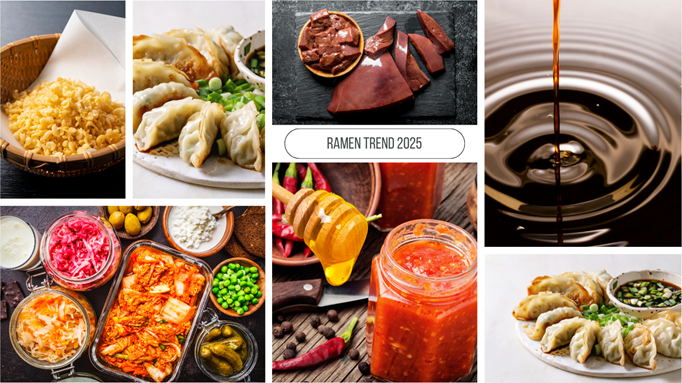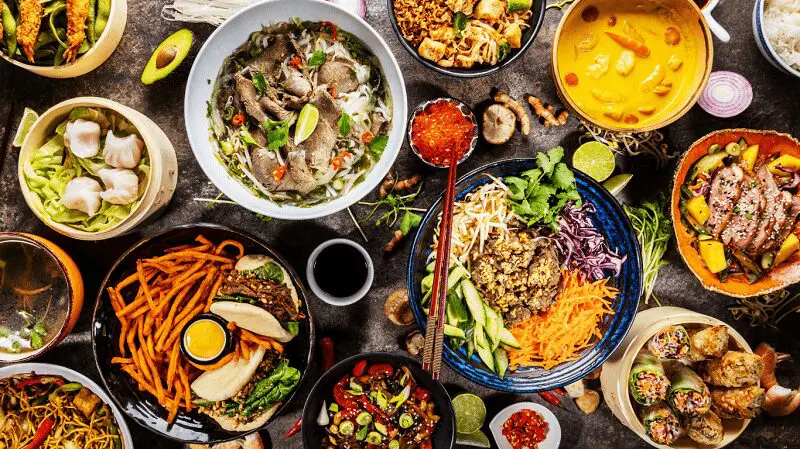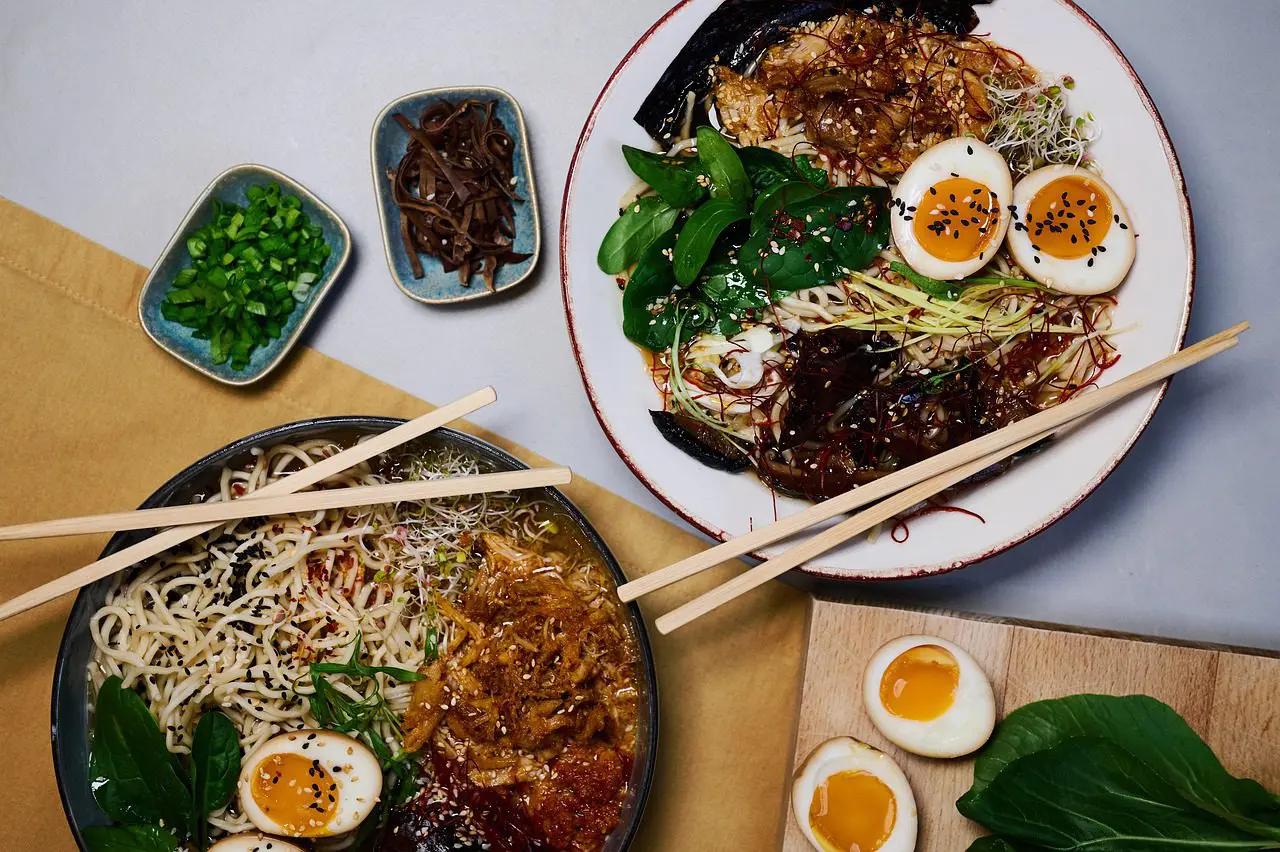Japan vs. U.S. Food Delivery Comparison: How Ramen Delivery Has Evolved So Far!
Published: Dec 16, 2022/ Last Updated:Dec 16, 2022
- 9 min read

Attention ramen fans nationwide! In this issue, we would like to explore the food delivery industry, which has developed remarkably in recent years. Did you know that as many as 60% of people in the U.S. order takeout or delivery at least once a week (see 20 Food Delivery and Online Ordering Statistics for 2021), and that the amount of money spent on takeout or delivery amounts to $16 billion per month (see The Tasty History of Takeout & Delivery)? Food delivery has become an integral part of our modern lives. In this issue, we would like to compare the history of food delivery in Japan vs in the U.S. and where ramen stands in-between. We’ll start with the history of food delivery in both countries before diving into the challenges and solutions of delivering a soup-based dish such as ramen. From the determined botefuri of ancient Japan to the modern delivery apps of the internet, we’ll dive into the evolution of food transportation. We would like to share how these services relate to Myojo USA’s ramen and what the future holds for ramen delivery. Let’s get started!
- Index
- The History of Food Delivery in the United States
- About the History of Food Delivery in Japan
- Challenges facing ramen delivery and their solutions
- Conclusion
■The History of Food Delivery in the United States

First, we would like to explore how food delivery began in the U.S. Pizza may be your first guess, but the delivery business started somewhere unexpected. Around 1785, industrialization drove many people to the city in search of jobs. Those from the country found it difficult to buy milk as it wasn’t readily available in the cities. To meet this demand, services offering fresh milk started to pop up. Since refrigerators were not yet common in homes, milk was delivered every day to customers’ doors. The milk delivery business gradually developed into an indispensable service for people living in the cities.
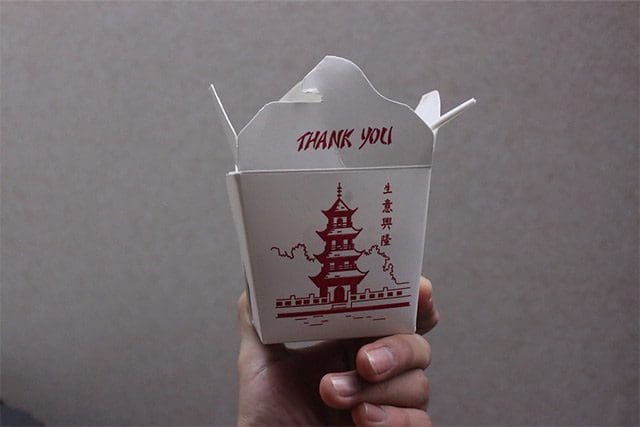
The next food delivery service took off in Los Angeles in 1929. Kin-Chu café advertised itself as ” the only place on the West Coast making and delivering real Chinese dishes” and is arguably the first restaurant in the United States to offer a food delivery service. It was well received but unfortunately came to a halt in the wake of the Great Depression of the 1930s and the ensuing World War.
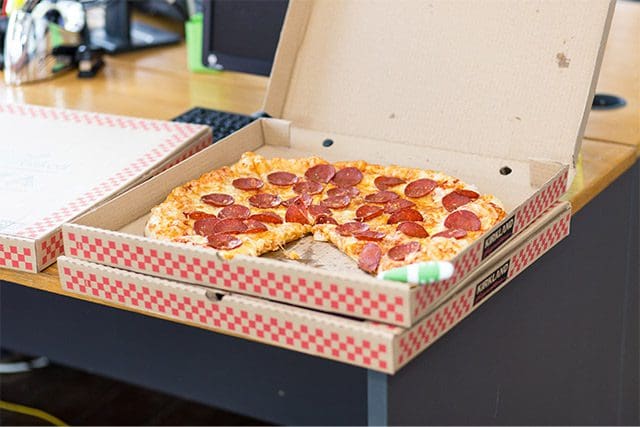
It was after World War II that pizza finally took center stage in the food delivery business. Soldiers that served in Italy returned home craving the taste of the authentic pizza they enjoyed overseas. To meet this demand, pizza restaurants in New York and Los Angeles began offering delivery services, which paved the way for future franchises such as Domino’s and Pizza Hut to dominate the delivery game.
It was the pizza industry that first utilized the internet as an electronic storefront. In 1990, Pizza Hut launched PizzaNet, the first website that allowed customers to order pizza online, as well as the first website that sold food on the Internet. Fun fact, the first order placed on PizzaNet was “A large pepperoni with mushrooms and extra cheese.”
As the internet developed, so did its involvement with the food industry. A pioneer of this trend was waiter.com, which launched its service in 1995. Considered to be the first online restaurant delivery service, waiter.com worked with 60 or so restaurants in the San Francisco Bay Area to offer home delivery of chef-quality meals. Today, waiter.com is considered the first online restaurant-delivery service.
In the early 2010s, companies such as Doordash, Uber Eats, and Grubhub grew in popularity for offering delivery services on behalf of restaurants that otherwise didn’t deliver. This was a huge hit due to convenience and the variety of food from which a customer could choose. With this development, food delivery was no longer just about pizza. The closure of restaurants during the pandemic in 2020 brought about a demand for ordering in, allowing for minimal human contact. As a result, restaurant food delivery services have become an integral part of our lives in the United States.
■About the History of Food Delivery in Japan
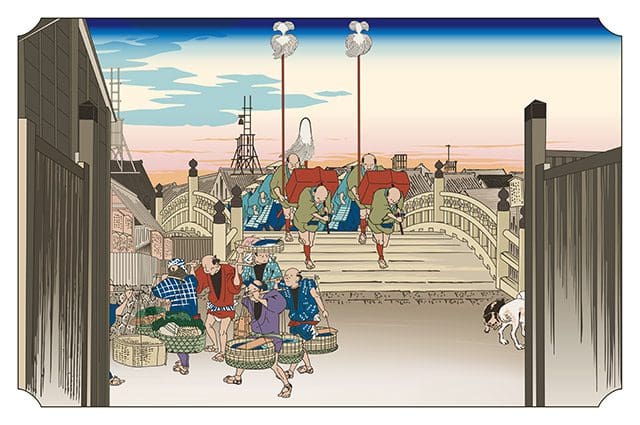
Halfway across the world, the history of food delivery in Japan looks very different from that of the U.S. Around the 18th Century, during the mid-Edo period, the service called demae (出前, meaning, “to go in front of”) offered home delivery of a variety of food. Demae is considered the predecessor to modern food delivery. In fact, one of the most popular online food delivery services in the country is called, Demae-can (出前館) in reference to the original business.
There were originally two main types of delivery services: those that took orders and delivered the food to the customers’ homes, and those that peddled the food. As for the start of the former, one theory is that it was a response to the courtesans in Yoshiwara, who were not allowed to go out freely. The dishes ordered at that time were soba (buckwheat noodles) and unagi (eel). As for the food peddling service, commerce was conducted by merchants who sold food held in wooden buckets and baskets balanced on each end of a pole. The merchant, botefuri (棒手振り), carried the pole on his back. They are often portrayed in ukiyo-e and Jidaigeki (a Japanese genre of film and television set in pre-Meiji Restoration Japan). The food they sold was diverse, ranging from fresh fish, vegetables, tofu, natto (fermented soybeans), various ingredients and even prepared foods. Worth noting is that the products botefuri handled were not limited to food, but also included herbal medicines, morning glories, and other daily necessities. The kingyo-uri (金魚売: goldfish vendor) were probably the most unique vendors, and although they’re not common to find nowadays parading through the streets selling goldfish, they are still a distinctly Japanese summer tradition.
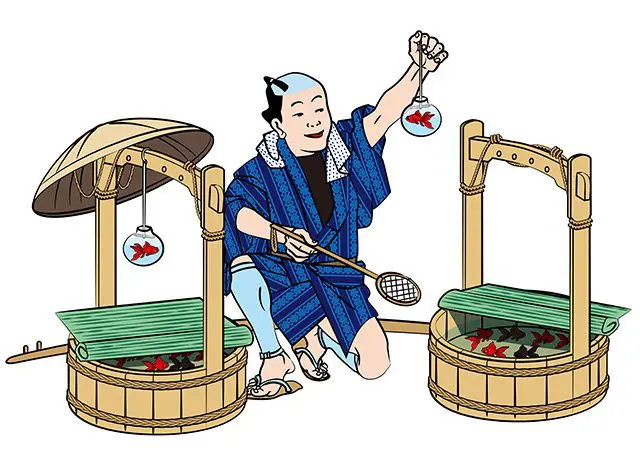
Thus, the Japanese delivery service began in the Edo period, and as time transitioned to the Showa period (1926-1989), home delivery services further developed with the introduction of the bicycle. Some of you may have seen pictures of delivery people riding bicycles while carrying their orders, such as layers and layers of buckwheat noodles on their shoulders. This style of delivery symbolizes the Showa era. Common types of restaurants that adopted delivery services at that time included soba noodle restaurants, Chinese restaurants, sushi restaurants, and cafes. By that point, customers had a much wider range of choices.
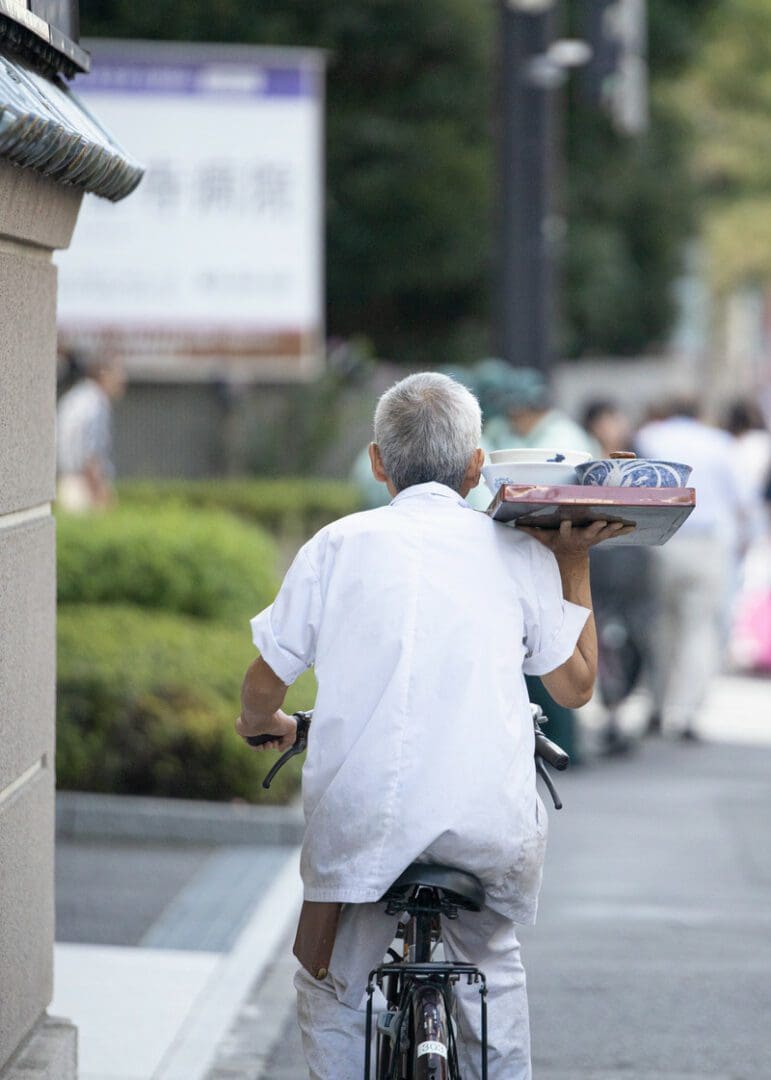
Nowadays in Japan, the internet is part of daily life and online food delivery services are now as common as in the U.S. Many menu items at restaurants can now be enjoyed at home. In addition to the aforementioned Demae-can, another popular online food delivery service in Japan is the U.S. based Uber Eats. Japanese food delivery services, which started as demae in the Edo period, have grown to an estimated market size of 4.44 trillion yen in fiscal year 2021 (see “Market size of food delivery in Japan from fiscal year 2016 to 2021 with forecasts until 2026“). This indicates that food delivery is now an indispensable part of daily life in Japan.
■Challenges facing ramen delivery and their solutions
So far, we have discussed the history of food delivery services in the United States and Japan, which differ greatly from each other due to cultural differences. Despite this, both countries developed online delivery services that allow customers to enjoy restaurant dishes without having to leave home. Naturally, ramen has entered the online delivery industry. However, it’s considered a particularly difficult menu item to transport. The primary reasons for this are that the noodles tend to become soggy easily and the soup turns cold quickly. In this section, we will delve into how ramen restaurants combat these difficulties.
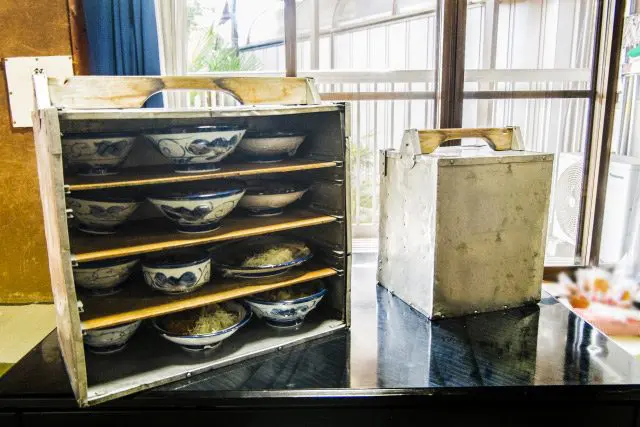
As mentioned in the previous section, the Showa period is when Chinese restaurants in Japan adopted the delivery service system. Since ramen was a common dish of these restaurants, it’s safe to say that they initiated the delivery of ramen. The boxes used to transport the order were called okamochi (岡持ち), and Chinese restaurants used an aluminum box with a lid that slid up and down. Generally, the ramen was poured into a bowl that was sealed with saran wrap to prevent the soup from leaking. Unfortunately, this method was not fool-proof and depending on the distance of the delivery, there was the risk of the noodles becoming soggy and the soup spilling. Still, at the time, this method was the best way for customers to enjoy restaurant-quality ramen at home. When finished eating, customers often left their empty bowls at the outside entrance of the home, where the delivery worker could pick them up later. This is a major difference from today’s food delivery services, which often use disposable containers.
As time progressed, so-called “ramen specialty restaurants” opened all over Japan, coinciding with the growth in popularity of the nationwide ramen boom. These specialty restaurants focused their effort on providing high quality ramen. As a result, many chefs refused to offer delivery as they didn’t want to compromise quality and risk serving soggy noodles. The common perception among Japanese people at that time was that “in order to enjoy ramen from ramen specialty restaurants at its best, one had to go to the restaurant,” and it wasn’t until recently that that opinion changed so that enjoying restaurant-quality ramen at home became commonplace again.
The pandemic forced the hand of many ramen restaurants to deliver their dishes to customers otherwise they risked going out of business. However, their desire to provide the highest quality ramen possible to their customers led many to come up with a variety of great ideas.
One method is that many ramen specialty restaurants began offering mazesoba, tsukemen, and other menu items that don’t run the risk of soggy noodles. In our opinion, this situation has had no small influence on the mazemen boom that continues to this day (see: WHAT IS THE DIFFERENCE BETWEEN MAZEMEN, ABURA SOBA, AND MAZESOBA?).
Another approach was to separate the soup, noodles and ingredients during transport for the customer to put together at home. Some ramen stores also began to deliver pre-cooked noodles, which required the customer to take the time to boil the noodles. In any case, the quality of ramen delivery has dramatically improved as customers can now enjoy non-soggy noodles at home.
Amazingly, the evolution continues to this day. Although we succeeded in delivering high quality ramen by separating the soup, noodles, and ingredients, this inevitably resulted in extra containers. A solution to this problem is a delivery-specific container that combines a medium-sized plate and a bowl. By using a medium-sized dish, the noodles and ingredients can be separated from the soup for delivery without the use of extra containers. This reduces the time and effort required for packaging and delivery. In addition, many other technologies were developed to support the evolution of ramen delivery, such as containers with excellent heat retention properties to keep soup hot and containers that are microwave safe. In this way, it is now possible to enjoy ramen at home with almost the same quality as at a restaurant.
■Conclusion
In this article, we look at the evolution of food delivery in the United States and Japan, and more specifically, their relation to ramen. Through trial and error, we now have a multitude of ways to enjoy ramen anytime, anywhere, and Myojo USA’s Fresh Ramen Noodles series is proud to take part. Perhaps the consumers’ desire for delicious ramen and the passion of ramen service providers to deliver it, continues to evolve the environment of ramen.
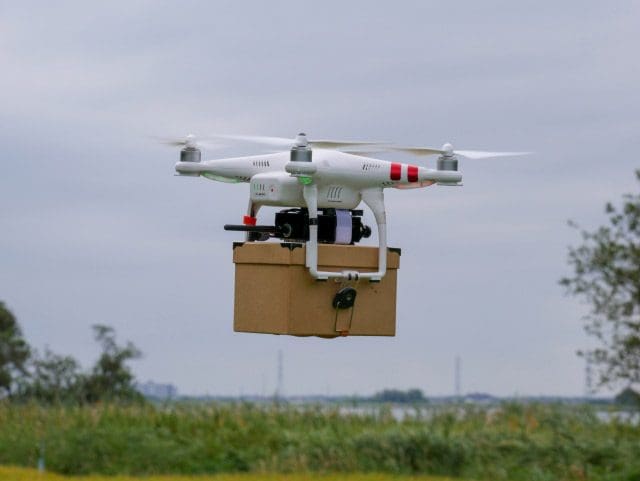
Finally, we would like to reflect for a moment on the future of ramen delivery. A hot topic in the food delivery industry these days is instrumentation of drones and unmanned self-driving vehicles. We have heard news that they have already been put to practical use in some areas, but will we soon see a future where, for example, drones deliver ramen noodles to your home? Personally, we think it will happen anytime soon. We can imagine that there will be many challenges in the process, but at the same time We are sure that they will overcome them with great ideas, just as they did with the coronavirus, where they solved various problems that arose in delivering delicious ramen one after another. The future of ramen flying through the sky to our homes was unimaginable to the people of the Edo period, let alone to us as children, but it is exciting to think that this will make eating ramen more and more accessible.
That is all for this article. Food delivery services have already become a familiar part of our lives, and we hope you learned something new by reading this article. Now, please look forward to another interesting ramen topic in the next issue!
Reference links:
Food delivery – Wikipedia
出前 – Wikipedia
岡持ち – Wikipedia
The history of food delivery: from local milk delivery to robots at your doorstep
The History Of Food Delivery: How Fast Takeout Became A Human Fact Of Life | History Daily
The History & Evolution of Food Delivery | Underscore_
20 Food Delivery and Online Ordering Statistics for 2021
Ordering in: The rapid evolution of food delivery | McKinsey
How did food delivery start? History of food delivery
History of Takeout & Delivery: When Did Food Takeout & Delivery Start? – Thrillist
History of Food Delivery and How It’s Changed
A Brief History of Food Delivery A Brief History of Food Delivery
Satisfying An On-demand Appetite For Food Delivery Services In Japan – Tokyoesque
Food Delivery: from Edo to present in Japan | Japan Travel by NAVITIME – Japan Travel Guides, Transit Search and Itinerary Planner
出前からデリバリーへ|飲食業の時代の変化についていく! | 食品包装容器 |木村容器株式会社
振売 – Wikipedia
江戸のテイクアウトとファストフード文化!?物売・屋台や寿司・天ぷらの販売方法も紹介 | 和樂web 日本文化の入り口マガジン
江戸時代のウーバーイーツ!?あんな物まで運んでいた!江戸時代の出前事情を解説 |ナンスカ
金魚から、納豆請負人まで!超活発だった江戸時代の「出前」産業 | オリジナルフード・ケータリングなら、東京発のフォリクラッセ
麺が伸びないの!?普通に美味しいデリバリーのラーメン – コグレマサト@ネタフル | Yahoo! JAPAN クリエイターズプログラム
どうやって届くの!?デリバリーでラーメンを頼んでみた!|シティリビングWeb
ウーバーイーツのラーメンはのびる?取られている対策方法を解説! | counter-attaaack
Uber Eats (ウーバーイーツ)でラーメンを注文してみた【体験談】
「出前館」と「エフピコ」が共同開発! 麺類向けのデリバリー特化型容器、販売開始! | 出前館 | 株式会社出前館
麺類のテイクアウト容器はどんな種類がある?重要な2つのポイントを紹介 | 折兼ラボ | 株式会社折兼
When Did Pizza Delivery Start? – Salerno’s Pizza
When Was The First Pizza Delivery? – Quick USA Food History
